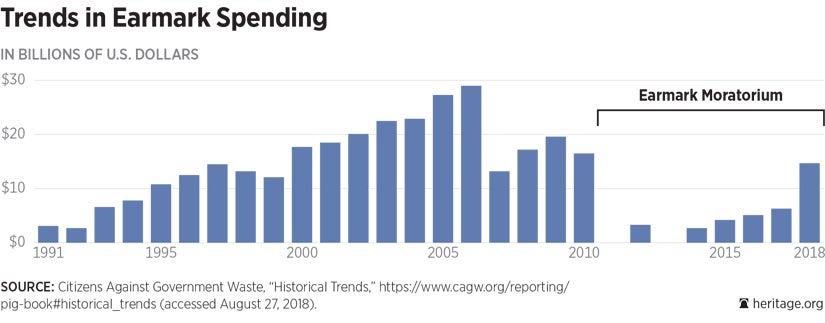
THE ISSUE
- Several legislators have suggested officially reviving earmarks, as memory has faded of why they were banned in the first place.
- Congress should permanently ban earmarks by statute, such as proposed by S. 2330.
- Congress should pursue more effective ways than earmarks to exercise its power of the purse.
BACKGROUND
- The earmark process was intended for lawmakers, to target specific areas of need in their home states, and for most of its history was only sparingly used.
- In the early 1990s, earmarked spending began to shoot upward, reaching a high of $29 billion in 2006.
- Congress adopted an earmark moratorium in 2011. The moratorium is not binding and is at risk of being reversed through a rule change.
- Earmarks have informally crept back into the appropriations process and they are on the rise again.
EARMARKS ARE INEFFECTIVE
- Proponents suggest that earmarks could help Congress pass appropriations bills on time.
- In 2006, the peak of earmark spending, only two appropriations bills passed on time. In the 10 years prior to the moratorium, Congress never enacted more than four stand-alone appropriations bills on time.
EARMARKS ARE WASTEFUL
- The bridge to nowhere was proposed to connect Ketchikan, Alaska, with Gravina Island, home to 50 people. Construction of the project was finally scrapped after costs rose to nearly $400 million.
- Turtle tunnel. Congress earmarked $3.4 million in 2009 for a turtle crossing under a Florida highway.
EARKMARKS SPAWN CORRUPTION
- In 2005, Representative Duke Cunningham (R–CA) admitted to receiving millions of dollars in bribes in return for directing defense contracts.
- In 2005, lobbyist Jack Abramoff and his associates were exposed for bribing legislators with gifts and campaign contributions for votes on earmarked funding.
EARKMARKS FAVOR THE POWERFUL IN CONGRESS
- In the last session of Congress before the moratorium began, 61 percent of earmarked dollars came at the request of the 81 Members of the House and Senate Appropriations Committees—15 percent of Congress controlled nearly two-thirds of all earmarked funds, according to Citizens Against Government Waste.
CONGRESS MUST EXERCISE ITS POWER OF THE PURSE
- Regularly review federal programs to ensure that funding criteria reflect the needs of Americans.
- End unauthorized appropriations. In FY 2018, Congress appropriated $318 billion to unauthorized programs, effectively putting yet more programs on auto-pilot without regular congressional review.
For more information on earmarks read Heritage Foundation Backgrounder No. 3353, “Earmarks Won’t Fix the Broken Budget and Appropriations Process.”



